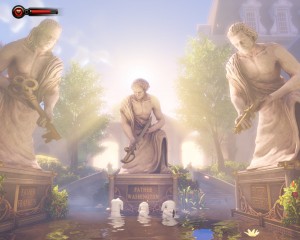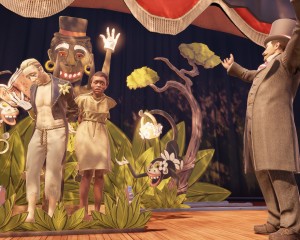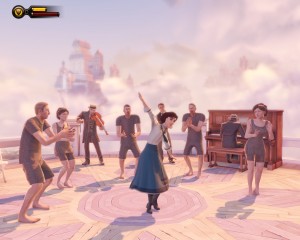Bioshock Infinite was a game that I wasn’t intending on playing, but thanks to a gift from a friend and everyone talking about it I decided to load it up.
Now, I may be the best (or worst) person to examine Bioshock Infinite as I disliked the first Bioshock and found it to be one of the most overrated games of the last decade: too much style, not enough substance. With Infinite, this is the third game in the series and the second one by Irrational Games. So, is third time’s the charm for me, or is it a case of crash and burn ?
(The following analysis will not be spoiling Bioshock Infinite’s story except for what has been revealed through promos and previews. However I will be discussing the game mechanics at length for those wanting to play the game blind.)
Capitalistic Capitalism:
Bioshock Infinite is in a sense a spin-off from previous games in the series. We’ve moved from the underwater city of Rapture to the floating city of Columbia. Where Rapture was a city built on the philosophy of Ayn Rand, Columbia is a city that has taken the concept of Capitalism and American Patriotism and turned it into a religion.
Taking place around the start of the 20th century, Columbia is a place where the founding fathers are viewed as Gods and that white Americans are viewed as the superior race. You play as Booker Dewitt: a man with a troubled past as big as the debt he owes. His debt has been called in and his only chance to pay it off is to head to the city and bring back a woman named Elizabeth to his creditors.
Let’s get the good out of the way: Bioshock Infinite looks amazing. Everywhere you go it’s hard to not admire the work that has gone into the art design. From massive statues to simply wandering around on a boardwalk, this is definitely a strong showing for best looking game of the year.
Unlike the first Bioshock where you were exploring a ruined city, Columbia is a city very much alive. The developers have done a great job in showing all the layers of the city. The art team has done outstanding work in making the city feel fleshed out, while still grounding the alternate technology and style to the period. Major areas have a larger than life feel to them and at the start, the city looks like a great place to live.
However the further you play, the more you can see the dark side of Columbia and what happens when Patriotism and Capitalism goes too far: From racism, to the gap between the haves and the have-nots and much more. But you won’t be experiencing the sights and sounds of Columbia alone, as Elizabeth will be your companion for most of the game.

Bioshock Infinite‘s art direction of Patriotism taken to the extreme makes it one of the most visually stunning games in a long time.
Besides giving Booker a reason to talk, Elizabeth provides ammo, money and life regen if you die. Elizabeth is a strong character and to discuss why would take us into spoiler territory.
Now let’s move on to the gameplay. As I mentioned at the start, I had problems with the original Bioshock’s design and how simplistic it was. While Infinite takes place at an earlier period in time, it does feature enhancements compared to the first game.
You can now fire guns and use vigors (Infinite’s form of plasmids) at the same time. The biggest addition to Bioshock Infinite is in the form of skyrails: massive rail systems that people can navigate via magnetized hooking devices. In many of the game’s open combat areas, you’ll find these rails set up for quick movement.
While riding them you can fire your weapons (but not use vigors) and can launch off of them to do damage to enemies below. This is an interesting way of providing verticality to a FPS.
However, while Bioshock Infinite takes two steps forward in gameplay, it takes three steps back and provides me with a number of problems with the formula.
The Same Song and Dance:
The heart of my problems with Bioshock came down to the developers creating an amazing world and filling it with mediocre gameplay and shooting. With Bioshock Infinite, the combat continues to be one of the worse elements of the game.
Having played FPS titles from WolfensStein 3D to today, I’ve gotten really good at getting a feel for the gunplay in a shooter. With Bioshock Infinite, the gun play has gotten worse in several areas. First is that you are now restricted to a two gun limit which in turn makes it very easy to run out of ammo during a critical fight.
The shooting in Bioshock Infinite is arcade like: pistols have the same range and accuracy as a rifle or single pulls of a machine gun. Most fights take place in huge environments where you’ll be sniped to death with pistols and machine guns. Aiming down the sights had no impact on accuracy and crouching seemed superfluous.
None of the weapons have any real weight to them with exception to the RPG. I expect more reaction from an enemy if I shoot them in the face with a shotgun, compared to how much the screen jerks when you get hit.
On the PC version I noticed that the developers left auto-aim on as I had cases where I got head shots when my cross-hair wasn’t on the enemy.
The weapons themselves are very generic for such a unique world: no crossbows or multiple ammo elemental launchers this time around. While there is a variation of almost every weapon type, the differences are not radical enough to give the player a wide variety of weapons.
The vigor UI was definitely made for a console audience and not translated well to the PC. You can only have two vigors available for quick switching and there apparently is no way to easily set up which two. The vigors themselves don’t seem as creative this time around with very few instances where you could use them on the environment.
In fact the gameplay itself is overall smaller in Bioshock Infinite. Gear: which replaces the modifying tonics lack the variety and choices seen in Bioshock. The gear bonuses are different each time you play based on set designs and positions, while featuring situational bonuses such as causing enemies to get set on fire when you melee them. But with only four slots and the situational nature, once you find the ones you like, there is no need to switch again.
One of my favorite parts of the original Bioshock was the research camera that provided bonuses based on analyzing enemies. That feature is gone and there are very few enemy types in Infinite. This is particularly troublesome as you’ll only fight two enemies that make use of vigors which seems like a huge oversight.
There doesn’t appear to be any major improvements in the enemy AI, as most enemies will either charge at you, or stay in one area trying to snipe you. There were never any moments where I felt like I was fighting an enemy on even terms such as in The Darkness 2.
Major enemies are difficult by the fact that their attacks can be hard to dodge and the huge amount of health they have. But these enemies play by their own rules and it is not the same as having to fight fire with fire.
While the use of the skyrail system was a great touch, the world of Infinite feels smaller compared to the original. Levels are mostly linear with few exceptions and the game’s story moves you from set piece to set piece. The skyrail system also feels underused and only appears in a few set piece battles as opposed to exploring the city.

The game’s use of racism and propaganda are just a few of the major themes that are played out over the course of the game
The set pieces also make the idea of setting up traps and preparing for enemy fights impossible as the game goes on.
Since you’ll be stuck in the piece until you beat all the enemies, you can’t prepare and set up traps. Also with the areas so big it makes using the trap variation of the vigors very difficult.
One of the poorest decisions of Bioshock Infinite is the annoying checkpoint system. There were points where I would go 15 to 30 minutes without having the game save my progress. This is made all the more annoying by the fact that the game doesn’t always checkpoint after major fights.
Even though I’m avoiding mentioning any story spoilers there is one minor aspect of the plot that I have to touch on: the world itself. Bioshock Infinite’s setting of Columbia is less detailed compared to the city of Rapture. In the first game, the developers did a good job of expanding on the lore and world of Rapture to explain how these powers came about and the influence on the world itself.
With Columbia, there is no real attempt at explaining the influence of the vigors or why the enemies reacted as they did. A lot of the game mechanics require you to suspend your disbelief as they clash with the world around you. You find a vigor that gives you a bullet shield, but nothing that would let you hold more than two guns. Another is how if everyone is searching for Elizabeth, then why are they always focusing on Booker instead of capturing her?
Or if this is a world where the upper class rules the downtrodden, why are there vending machines for gun upgrades and vigors all over the place? Calling back to my piece on world building, Columbia feels like a world designed around the player instead of as its own separate entity.
In regards to Elizabeth, while she is a well defined character, I felt that the designers went too far in trying to make you grow attach to her. She becomes your life-line: supplying you with ammo, health and money which can become a life saver. However, outside of a very specific mechanic I would have liked to have seen more growth both from a story perspective and from a gameplay.
She only reacts at specific instances and for the most part is quiet. Also it would have been interesting if you could rely on her during combat or simply to carry emergency supplies. Instead it feels like Elizabeth is there only when the designers want her to be and can be ignored everywhere else. A huge missed opportunity would have been for her to comment about the previous fight or what tactics you use.
Ultimately I can sum up my problems both with Bioshock Infinite and the first game with the following statement: The world and narrative of the game clashes with the gameplay presented.
To put it another way, Bioshock Infinite is like someone who restored a classic car with an amazing paint job, but average quality parts.
For the general consumer it looks great and handles adequately, but for the people who appreciate cars both visually and under the hood, the problems stick out like a sore thumb and devalue it.
I could go on for at least several hundred more words but I would be getting into spoiler territory. Bioshock: Infinite is a game that I want to love, but being built on top of so many questionable mechanics is too much for me to overlook and uniformly praise the game. There is a reason why the tagline for this site is: “to critically examine game design and the industry” after all.
(One final note: this analysis was based on playing and beating the game on hard mode.)





Pingback: 5 Cures to Modern FPSes - The Darkness 2 | Game Wisdom()
Pingback: Perceptive Podcast -- Head-to-Head: Narrative vs. Design | Game Wisdom()